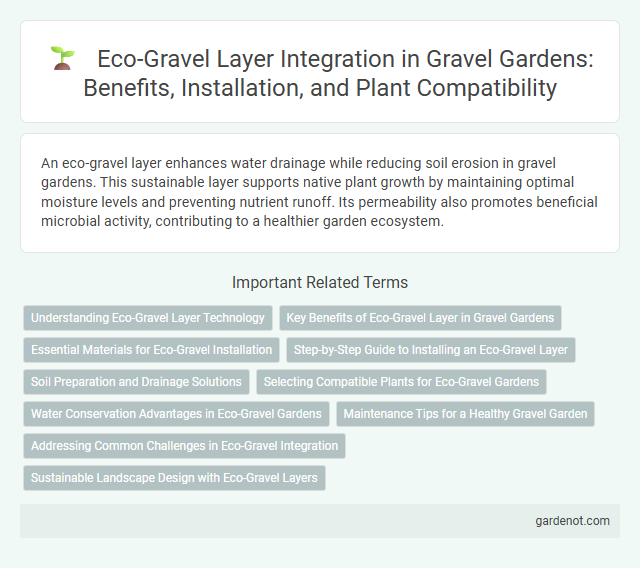An eco-gravel layer enhances water drainage while reducing soil erosion in gravel gardens. This sustainable layer supports native plant growth by maintaining optimal moisture levels and preventing nutrient runoff. Its permeability also promotes beneficial microbial activity, contributing to a healthier garden ecosystem.
Understanding Eco-Gravel Layer Technology
Eco-gravel layer technology enhances soil permeability and promotes sustainable water drainage by utilizing crushed stones with specific particle sizes that create interconnected voids. This innovative method reduces surface runoff and soil erosion while supporting plant root aeration in gravel gardens. The eco-gravel layer optimizes stormwater management and fosters healthier garden ecosystems through natural filtration processes.
Key Benefits of Eco-Gravel Layer in Gravel Gardens
Eco-gravel layers enhance gravel gardens by improving soil drainage, preventing waterlogging and root rot in plants. They create a natural filtration system that reduces weed growth and supports sustainable water management. This eco-friendly solution promotes healthier plant growth while maintaining the garden's aesthetic appeal and environmental balance.
Essential Materials for Eco-Gravel Installation
Essential materials for eco-gravel installation include permeable geotextile fabric, which prevents soil erosion while allowing water infiltration, and a base layer of crushed stone to enhance drainage and stability. Organic mulch or compost may be integrated beneath the gravel to support soil health and promote beneficial microorganisms. Proper grading tools ensure the surface is even, facilitating effective water runoff and preventing pooling.
Step-by-Step Guide to Installing an Eco-Gravel Layer
Create a stable base by excavating the area to a depth of 4-6 inches and compacting the soil. Spread a 2-3 inch layer of eco-gravel, made from recycled materials or natural aggregates, ensuring even distribution for effective drainage. Finish by leveling the surface and tamping down the gravel to secure the layer, promoting sustainable landscaping and water conservation.
Soil Preparation and Drainage Solutions
Creating an effective eco-gravel layer begins with thorough soil preparation, including the removal of weeds and debris to ensure proper root growth and stability. Incorporating a compacted sub-base such as crushed stone or coarse sand enhances drainage by preventing waterlogging and directing excess moisture away from plant roots. Installing a permeable geotextile fabric further improves drainage solutions by separating soil layers while allowing water to pass through efficiently, promoting sustainable garden health.
Selecting Compatible Plants for Eco-Gravel Gardens
Selecting compatible plants for eco-gravel gardens involves choosing drought-tolerant species that thrive in well-drained, nutrient-poor soils typical of eco-gravel layers. Succulents, ornamental grasses, and Mediterranean herbs like lavender and thyme are ideal for maintaining soil integrity and supporting local biodiversity. Integrating native perennials ensures minimal water usage and promotes sustainable growth within eco-gravel garden ecosystems.
Water Conservation Advantages in Eco-Gravel Gardens
Eco-gravel layers enhance water conservation in gardens by improving soil moisture retention, reducing evaporation, and minimizing runoff. Their porous structure allows rainwater to infiltrate slowly into the ground, replenishing groundwater levels and supporting plant health during dry periods. Incorporating eco-gravel helps create sustainable landscapes that require less irrigation and promote efficient water use.
Maintenance Tips for a Healthy Gravel Garden
Regularly raking the eco-gravel layer prevents compaction and promotes proper drainage, essential for plant health in a gravel garden. Removing debris and fallen leaves minimizes organic buildup that can lead to weed growth and soil imbalance. Applying a weed barrier fabric underneath the gravel plus occasional top-ups of fresh gravel maintain aesthetics and functionality over time.
Addressing Common Challenges in Eco-Gravel Integration
Eco-gravel layers effectively address common challenges in garden integration by enhancing soil permeability and reducing surface runoff, which prevents waterlogging and erosion. Their porous structure supports healthy root growth and promotes natural drainage, making them ideal for sustainable landscaping. Incorporating eco-gravel also minimizes weed growth and maintenance requirements, contributing to long-term garden resilience.
Sustainable Landscape Design with Eco-Gravel Layers
Eco-gravel layers enhance sustainable landscape design by promoting natural water infiltration, reducing soil erosion, and minimizing runoff. These layers, composed of permeable, recycled materials, support healthy plant growth while preventing compaction and soil degradation. Integrating eco-gravel contributes to low-maintenance, eco-friendly garden systems that conserve resources and improve urban biodiversity.
Eco-gravel layer Infographic

 gardenot.com
gardenot.com